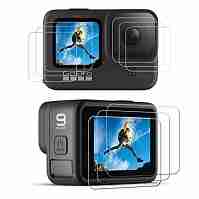
Action cameras have become essential companions for adventurers, travelers, and everyday enthusiasts capturing life’s most thrilling moments. Whether you’re diving into the ocean, skiing down powdery slopes, or biking through rugged terrain, your action camera is your ticket to reliving those adrenaline-pumping experiences. However, the durability of these cameras is often put to the test in extreme environments. This is where the importance of Action Camera Protector comes into play.
In this comprehensive guide, we’ll delve into the world of action camera protectors. We’ll explore why they are essential, the different types available, and how to choose the best one for your needs.
The Need for Protection
Action cameras are built to withstand a fair amount of punishment, but they aren’t invincible. Here are a few scenarios where having a protector is crucial:
- Physical Impact: During action-packed activities like mountain biking or skiing, your camera can take hard knocks or falls. A protector can absorb shock and prevent damage.
- Water Exposure: Many action cameras are designed to be waterproof, but prolonged exposure to water can still be harmful. A protector can provide an additional layer of defense against moisture and corrosion.
- Dust and Debris: When you’re off-road or in dusty environments, fine particles can find their way into your camera’s delicate components. A protector seals off these vulnerable areas.
- Scratches and Scuffs: Everyday wear and tear can leave your camera’s lens and body scratched. A protector safeguards against these minor damages.
Types of Action Camera Protectors
Action camera protectors come in various forms, each tailored to specific needs and environments. Let’s explore the most common types:
- Lens Protectors: The lens is perhaps the most vulnerable part of your action camera. Lens protectors are usually made of tempered glass or hard plastic and shield against scratches, impacts, and dirt.
- Housing/Casing: Some action cameras come with protective casings, which are essential for underwater use. These housings are often waterproof and provide all-around protection.
- Screen Protectors: A screen protector guards your camera’s display from scratches and impacts while ensuring visibility remains unaffected.
- Frame/Shell: A protective frame or shell wraps around the camera body, offering shock absorption and impact resistance without adding much bulk.
Choosing the Right Protector
Selecting the right protector depends on your camera model and the activities you engage in. Here’s how to make an informed choice:
- Compatibility: Ensure that the protector is compatible with your specific camera model. This includes not only the brand but also the camera series (e.g., GoPro Hero 9, DJI Osmo Action).
- Material: Opt for high-quality materials like tempered glass or durable plastics. These materials provide optimal protection without compromising on clarity or touchscreen sensitivity.
- Waterproofing: If you frequently use your camera underwater, invest in a waterproof casing or housing that can withstand the depth and pressure you’ll encounter.
- Ease of Use: Consider how easy it is to install and remove the protector. Some protectors use adhesives while others snap into place, so choose based on your preference.
Installation and Maintenance Tips
Once you’ve selected the right protector for your action camera, follow these tips for installation and maintenance:
- Cleanliness: Before applying any protector, ensure the camera’s surface is clean and free from dust or debris. Use a microfiber cloth and cleaning solution if necessary.
- Installation: Follow the manufacturer’s instructions carefully to apply the protector correctly. Take your time and avoid rushing the process to prevent air bubbles or misalignment.
- Regular Checks: Inspect your protector periodically for signs of wear or damage. Replace it if you notice any cracks or scratches, as compromised protectors may not offer adequate defense.
- Cleaning: Clean your protector regularly with a soft cloth to remove dirt and smudges. Avoid abrasive cleaners or rough materials that could scratch the protector.
Conclusion
In conclusion, protecting your action camera with a suitable protector is essential for prolonging its lifespan and ensuring optimal performance in challenging conditions. Whether you’re an avid adventurer or a casual user, investing in a high-quality protector tailored to your camera’s needs will pay dividends in the long run.
Remember to consider factors such as compatibility, material quality, and the type of protection required when choosing a protector. Follow proper installation and maintenance practices to maximize the effectiveness of your protector and keep your action camera in pristine condition for all your future adventures. With the right protection, you can focus on capturing breathtaking moments without worrying about the safety of your valuable device.